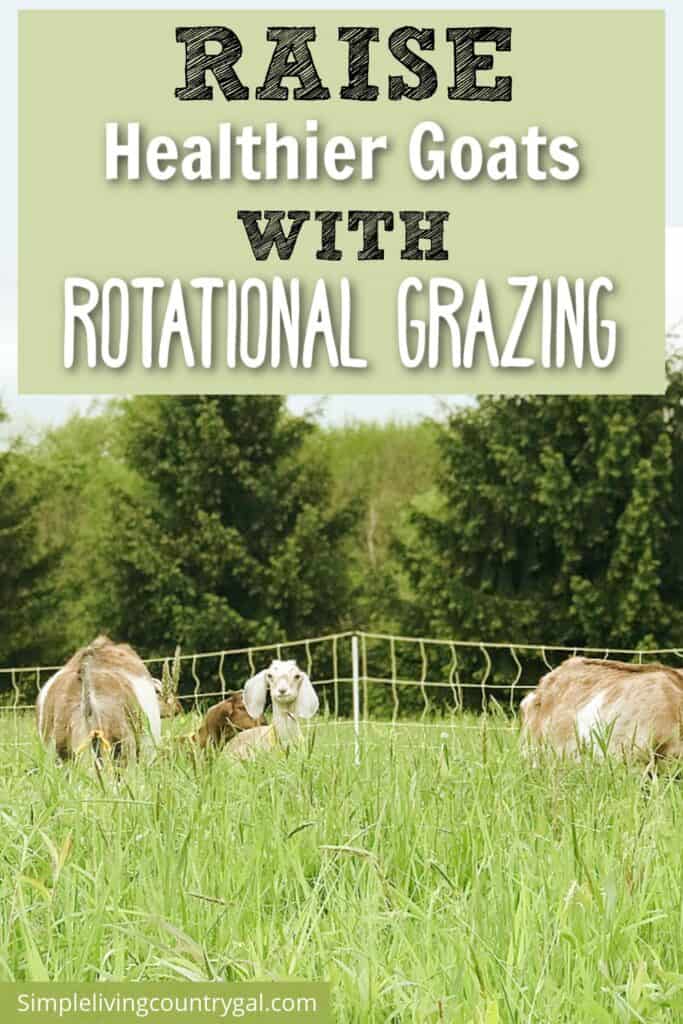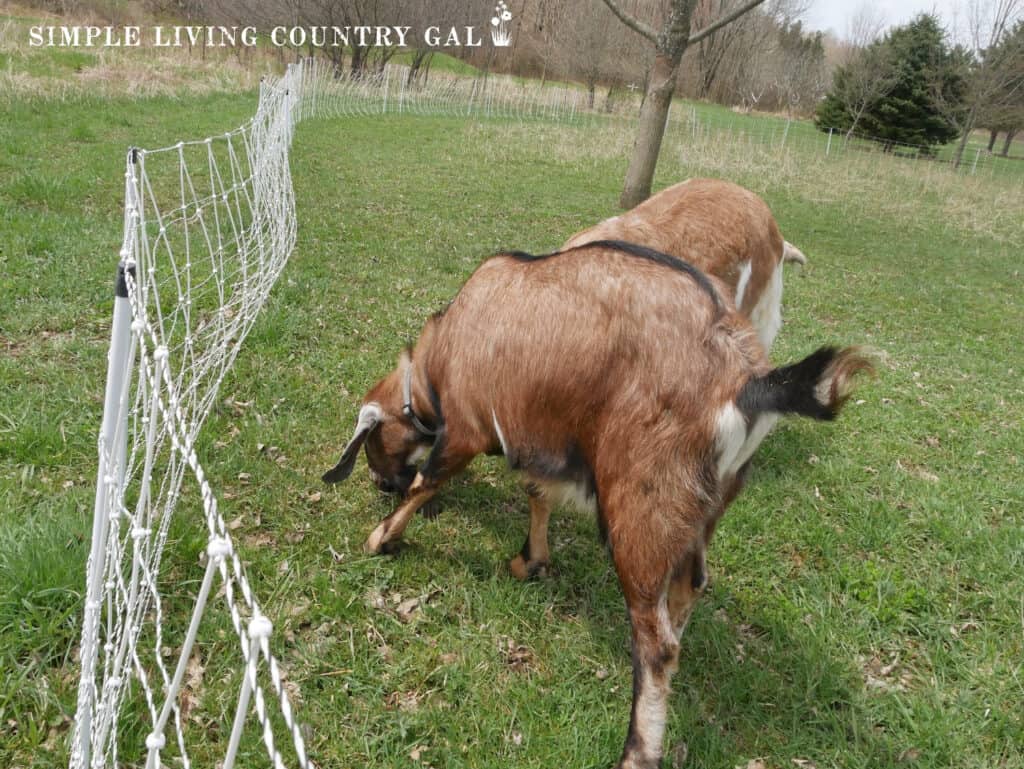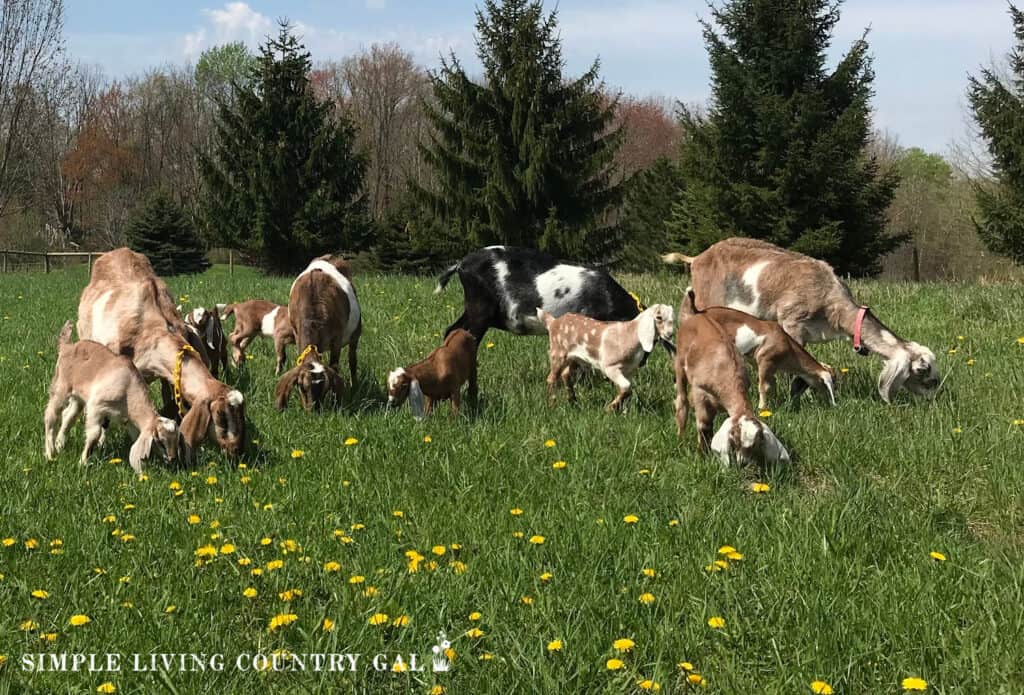rotational grazing goats
If you are looking for tips on raising healthier livestock, rotational grazing goats is the answer. Use this approach to give your goats the best pasture to graze on, using a system that will keep them and your grass at their healthiest.
Routines for caring for and feeding your animals will help you with how to raise dairy goats that are healthy and strong enough to fight off worms and other parasites.

Livestock owners are always looking for ways to ensure their animals remain healthy. This is especially true with the food and browse you offer them. If your pasture is less than perfect, no problem, you can use rotational grazing to promote healthier and more robust grasses for your goats to enjoy.
This practice not only gives your goats access to fresh pastures regularly; it can also help prevent worm overloads. Let’s walk through what there is to know about rotational grazing dairy goats, from how much pasture is necessary per goat, and look at a sample routine you can implement with your own herd.
What is rotational grazing?
Rotational grazing is sectioning off an area of pasture giving a herd of goats access to only one section at a time while the rest of the areas are rested. This allows for even usage of the pasture and prevents overgrazing as well as parasite overloads. Instead of allowing your goats to graze continuously on one area of the pasture, you rotate them between different areas using fences to differentiate them.

How much pasture does a goat need?
If you are allowing your goats to fully graze on your pasture, then you will want to have about 1,000 square feet of pasture per head. This means that if you have 5 goats, you will want to have about 5,000 square feet of designated grazing area.
If you are rotational grazing, you can reduce that number significantly because your goats will only be in one area for a shorter period of time. Rotational grazing is also helpful If your pasture is too small for your herd’s size. Moving them around routinely will help you maximize pasture usage and keep your goats and your pasture healthier.
How to section off a pasture
How you section your pasture will depend on its size and the number of goats you plan to keep. For our setup, we have 4 acres of pasture, and we section that area into 4 quadrants for a herd of 15-20 goats.
To create the different sections or paddocks, we use electric fence netting. It is easy to move around and is very effective at keeping goats contained.
Petween Electric Fence Netting for Sheep, Lambs, Goats, Dogs, 35


Setting up a routine for rotational grazing
Once you have your pasture sectioned off, you will then want to set up a routine grazing schedule for your herd. For our setup, we move our goats to a new area every 3-6 weeks. The frequency all depends on the time of year and how often our herd is out each day.
If you have smaller paddocks, you will need to move more often. A good rule of thumb is every 2-3 weeks. Let the pasture be your guide starting out as the growth will give you clues when it is time to move.
Moving Goats Based on a Worm’s Lifecycle
Adult worms are found inside of goats, where they lay their eggs. Those eggs are then passed out in the goat’s feces. The eggs then hatch and develop into larvae out on the grass in a pasture. Worm larvae tend to stay about 4 inches or lower in the grass and can live for months at a time. If goats remain on that pasture they will ingest the larvae which will grow into more worms that will infest your goat.
Rotational grazing aims to upset that cycle, giving your goats more time to graze on clean grass. The longer you wait between paddocks the more time you will allow for the larvae to die. By moving to a new area every few weeks you can stay ahead of the worm cycle, greatly reducing outbreaks.
Example routine/schedule:
Keeping worms to a minimum is all about timing, and it’s for this reason why keeping a schedule is so important. Let’s look at an example schedule to give you an idea of how this all works. Remember, this is just a guide, and the times you allow your herd to graze before moving will depend on the size of our pasture and your herd.
- Day 1: Move the herd to a new paddock.
- Days 2-21: Allow the goats to graze in this area.
- Day 22: Close off access to this area and move the herd to another paddock.
- Repeat in a clockwise order.
If you have 4 paddocks set up, this schedule will give each paddock about 60 days of rest before the herd is back.
Fencing options for paddocks
When rotational grazing goats, it’s best to use temporary fencing that can easily be moved. There are a variety of fencing options available, such as electric netting or moveable panels, which make it easy to section off areas and keep goats from straying. Portable fencing is also ideal for rotational grazing because you don’t have to permanently fence in the pasture – you can check on the animals regularly and move them when needed.
More Goat Fencing Resources:

Other tips for rotational grazing
Let’s look at a few additional tips to consider when rotating your goat’s grazing areas.
- Paddock size matters – make sure the paddocks are large enough that the animals can get adequate nutrition before moving again.
- Monitor your goats and pastures closely – look for signs of overgrazing or nutrient-poor soil.
- Provide plenty of water for your goats – make sure they have easy access to clean drinking water while out grazing on pasture.
- Make sure you have adequate shade available for your goats – they need to be able to escape the hot sun during the summer months.
- Additional items to have – If needed, consider providing goat minerals and salt blocks in each paddock so that your animals are getting all of the nutrients they need.
- Utilize goat-proof fencing – this is especially helpful around areas with higher risk of predator activity, such as wooded areas.
Rotational grazing is a great way to manage pastures for your dairy goats. It not only helps keep the pasture healthy, but it also allows you to maximize the amount of space your herd has available. With the right fencing setup and a regular routine, rotational grazing goats can help ensure that your goats have access to fresh grass and other vegetation throughout the year.




